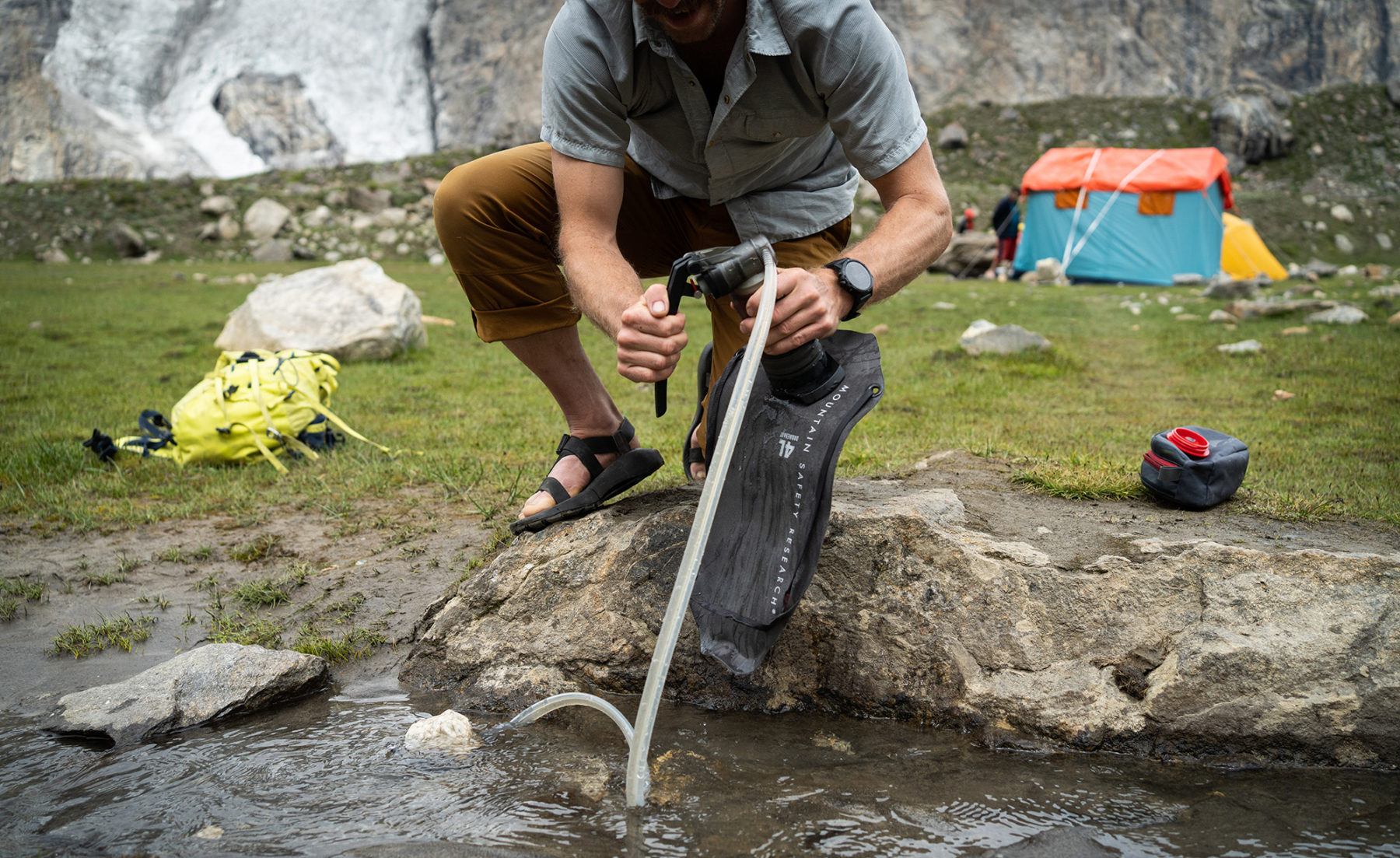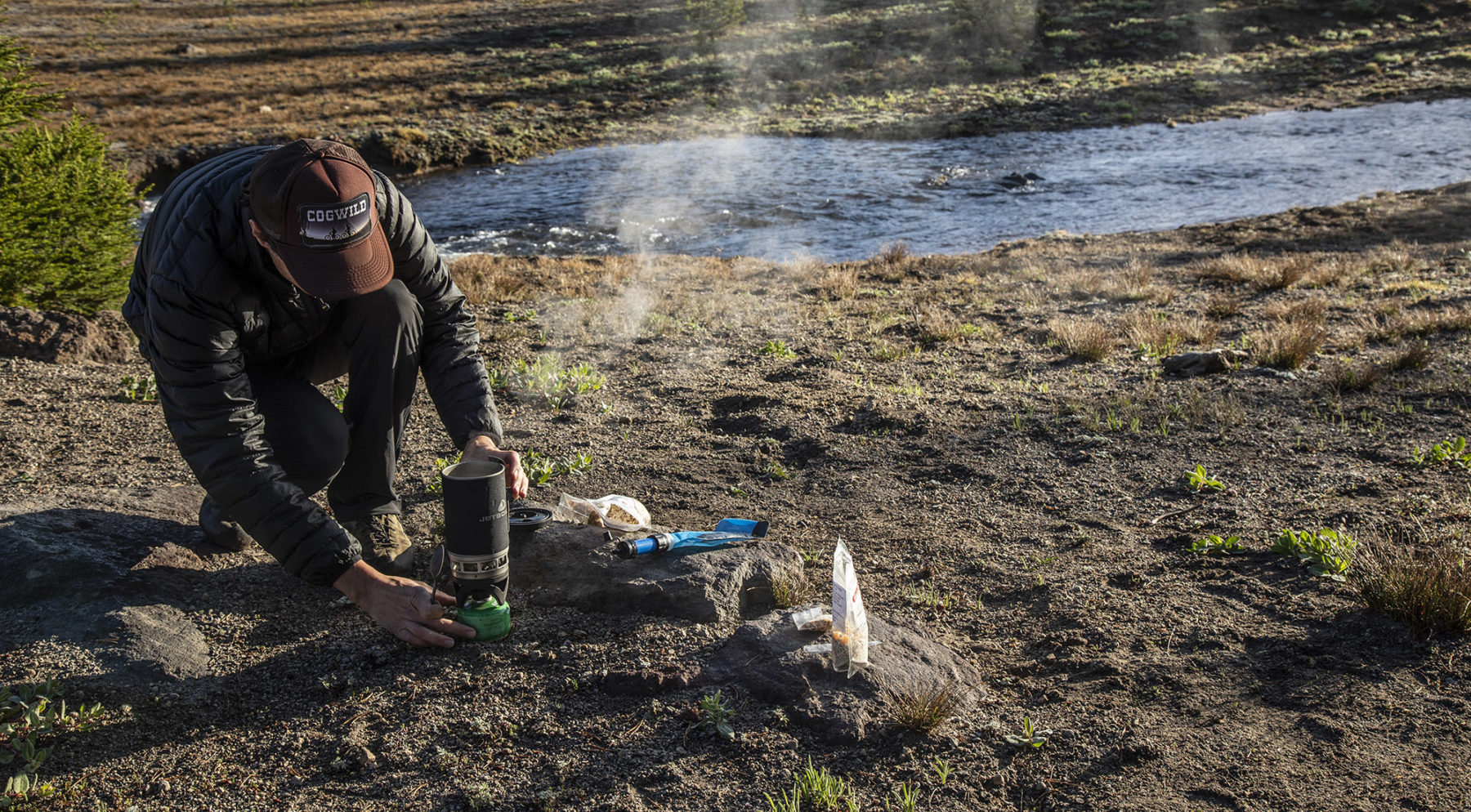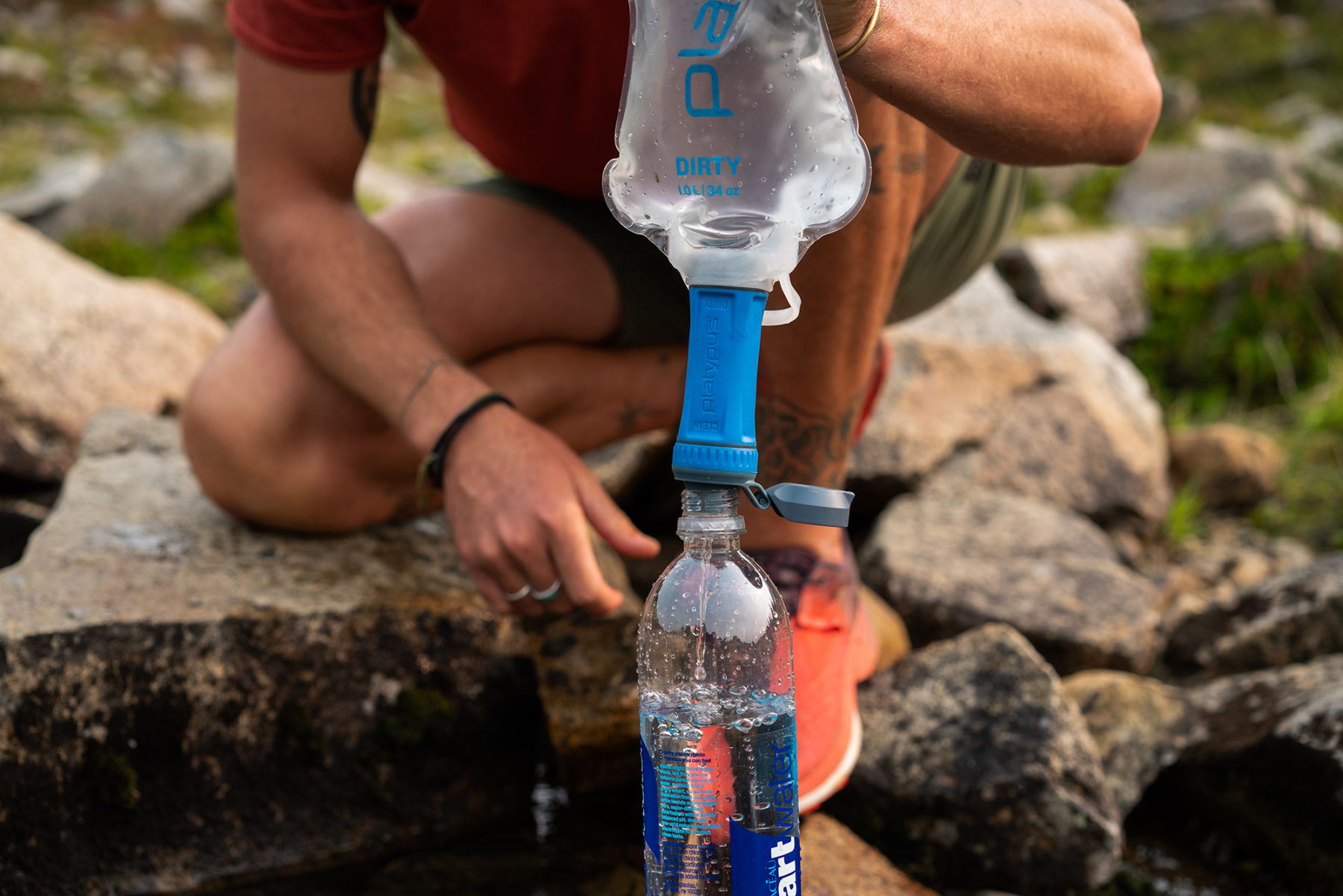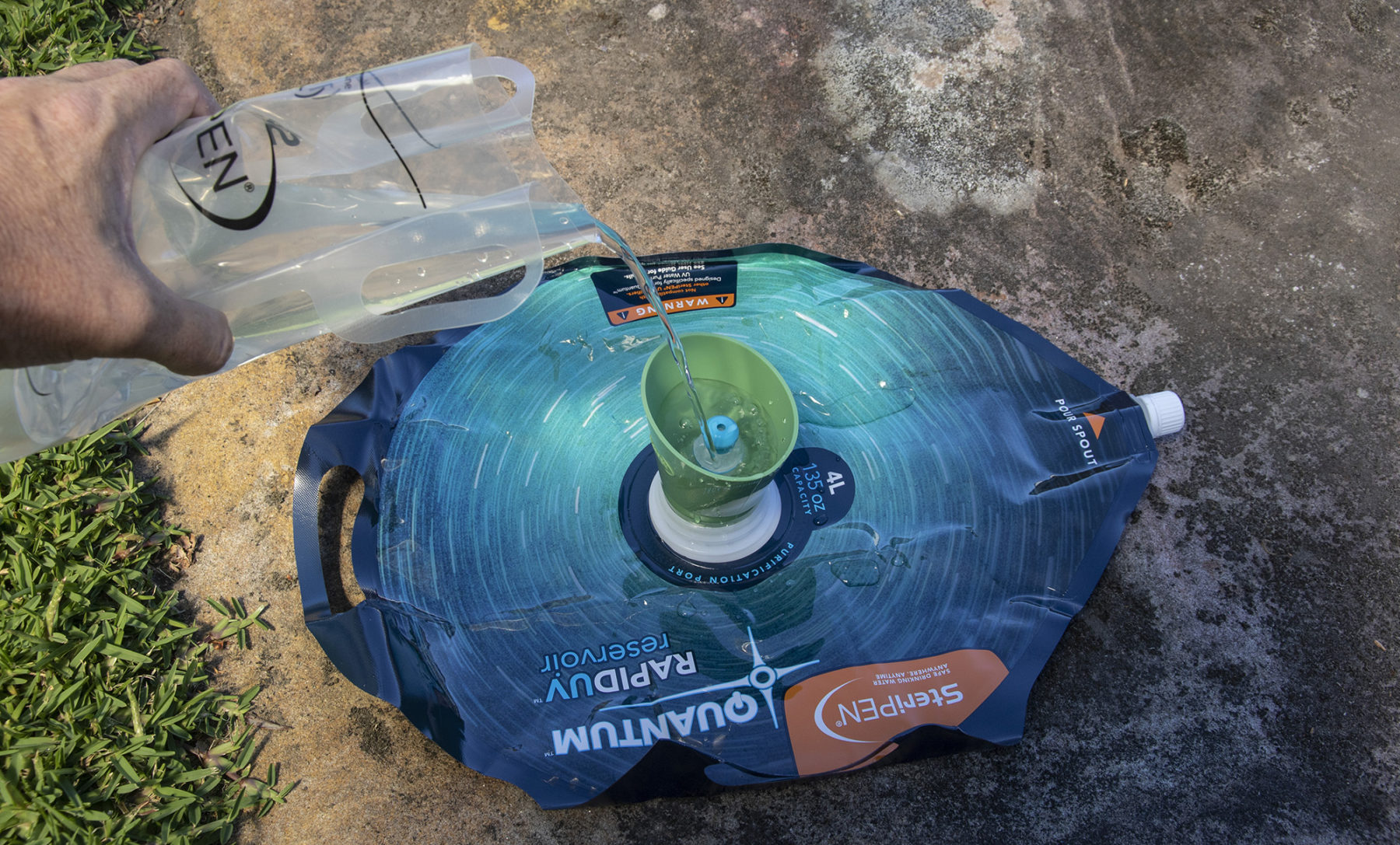The last thing you want when you’re travelling is to feel crook in the guts. No matter whether you’re hiking, biking, climbing or paddling, or just out for a weekend of camping, a tummy bug can turn even the most pleasurable of pursuits into the stuff of nightmares. A reliable water filtration system is the answer.
In worst-case scenarios, a tummy bug can physically inhibit you to the point where you can’t carry on, or it can make you seriously ill and in need of medical assistance, so it’s good practice to look after yourself by adhering to good hygiene practices, managing and storing your food safely, and having access to clean drinking water, which is where a water filtration system comes in.
On short trips of just a day or two, you’ll be able to carry clean drinking water with you, but this isn’t always an option for trips of longer duration. While water can be carried in a huge number of convenient containers suited to just about any adventure, it’s bulky and heavy, so on longer trips you’ll need to access water in the field… and there’s no guarantee that this water will be clean.
What’s in dirty water?
The four main contaminants in water include inorganic contaminants, organic contaminants, biological contaminants, and radiological contaminants. Even water that appears to be clean can contain harmful contaminants. If the water source is a stream that runs through farmland, for example, it could contain effluent from farm animals or run-off from fertilisers; tank water can contain sediments that may have been stirred up by recent rain; bore water can contain high levels of salts and naturally occurring chemicals; and other water sources can be contaminated by industry and contain all sorts of chemicals and heavy metals.

Physical contaminants can often be seen in water and can be quite easily detected by assessing colour, smell and taste, but microbial contaminants cannot be seen, so even if your water source appears crystal clear, has no odour and tasted fine, there is still no guarantee that it is safe to drink. Microbial contaminants include pathogens such as bacteria, viruses and parasites and, if ingested, can make you feel sick.
What can dirty water do to you?
One of the most common ailments from drinking dirty water is caused by giardia, which is a small parasite that causes giardiasis. Giardia can be found in water that has been contaminated by animal or human faeces, and once someone in your party has giardiasis, it can be spread from person to person. Short-term symptoms of giardiasis include diarrhoea, stomach cramps, nausea, vomiting and dehydration. Giardiasis usually lasts for two to six weeks, but in worst-case scenarios, long-term symptoms can include irritable bowel syndrome and recurring diarrhoea.
While there are several medicines to treat giardiasis, when you’re in the field the best advice is to stay hydrated by drinking plenty of fluids, but obviously not the contaminated water that made you sick in the first place.
Water that has been contaminated by faeces can also contain viruses including adenovirus, astrovirus, hepatitis A and E viruses, rotavirus, norovirus and other caliciviruses. These viruses can cause gastroenteritis which, like bacteria, can result in diarrhoea, stomach cramps, nausea, vomiting and dehydration. Some viruses can lead to more serious diseases such as encephalitis, meningitis, myocarditis and hepatitis. Oh, and as water passes through soils and rocks it can even pick up radiological contaminants, and long-term exposure can cause cancers.
Water filtration and contaminants
Fortunately, there are plenty of water filtration methods to eliminate contaminants. These include the simple act of boiling water before you drink it, adding purifier tablets, using pump or gravity filtration systems, as well as treating water with a UV light.
Filters come in all shapes and sizes and so not all are fit for purpose. Some are quite large and heavy, so you wouldn’t want to take them away on a hiking or climbing trip, for example, while others are small and light but might not have the water-purifying capacity for a large group of travellers.
It also needs to be pointed out that not all filtration methods filter out all types of contaminants, so if you’re travelling in an area where there might be high nitrate levels, then simply boiling water or running it through an inline filter will not do the job.
Boiling water
Boiling water before you drink it is a simple and effective way to remove bacteria and neutralise viruses, so if you don’t have a dedicated filtration and purification device, put the billy/pot/pan on the fire before you drink water to ensure you don’t end up with giardiasis. What boiling water won’t remove, however, is organic matter, heavy metals and pesticides. For that you’ll need a combination of filtration and purification systems.
We spoke with outdoor specialist Kent Cartner, who works with Travis Frenay from Valley Outdoors, and he advises that while boiling water makes it safe from viruses, a “big disadvantage is the flat taste that it gives the water once it cools”.

Filtration for hiking and biking
There are plenty of water filters on the market but most of them will not remove viruses, with a couple of exceptions. For hiking, bikepacking and camping, where you need a lightweight and compact device, an inline filter system is ideal. One example that can attach to your water bladder system is the MSR Thru-Link. This is inline filter simply clicks into your hydration reservoir to provide filtered water on the go. It has a two-stage filtration system with a fast-flow advanced hollow fibre filter (see next paragraph) that is claimed to remove pathogens, particulates and micro-plastics, and an activated carbon that’s claimed to reduce the presence of chemicals, tastes and odours. It can also be used as a gravity filtration system once at camp using your hydration reservoir.
For reference, hollow fibre filters contain hundreds of tiny tubes bundled together to create a filter matrix. The walls of the tubes have microscopic pores, and as water passes through the fibres, microbiological threats are trapped inside. These filters are perfect for hiking and biking because they are light, have high water-flow rates and are effective in clear and turbid water. You can also easily tell when they have reached the end of their useful life as backwashing will no longer restore flow and they simply clog up and stop working.

Another compact device is the lightweight (142g) pocket-size MSR TrailShot filter. This allows you to drink directly from water sources along the trail, or filter water to fill bottles. The TrailShot removes bacteria, protozoa and particulates. The MSR MiniWorks EX is a 456g water filter designed for frequent and heavy use. It has a carbon/ceramic element that can filter up to 2000 litres, and a solid activated carbon core to reduce unpleasant tastes, odours and chemical contaminants. Flow rate is one litre per minute and it can be attached to a range of wide-mouth bottles.
The QuickDraw MicroFilter + Reservoir System from Platypus is a “fill and squeeze” setup. Simply fill the reservoir and squeeze it to force water through the hollow fibre cartridge filter. You can drink direct or fill up water bottles and it is claimed to remove bacteria and protozoa, and has a flow rate of three litres per minute.
Another pump-free setup is the Platypus GravityWorks Bottle Kit. To operate you just fill the dirty reservoir and hang it. Water flows through the filter and into a connected bottle at up to 1.5 litres per minute. The microfilter can be backflushed and the system will remove bacteria and protozoa.
Water filtration for recreational camping
Weight and size are not as important when it comes to recreational camping, and for this pursuit you can upsize your filtration system.
MSR manufactures the TrailBase Water Filter Kit, which includes a gravity filtration system for use at camp and a small pocket-size filter for out on the trail. This system’s flexibility makes it suited to hiking, biking and basecamping.
Similar in design to the Platypus GravityWorks Bottle Kit (listed above), the GravityWorks Complete Kit is designed to cater to the needs of two to four people at camp. It filters up to 1.5 litres per minute, removing bacteria and protozoa, and is supplied with a range of adapters as well as a collapsible bottle.
There are also several products on the market that filter and purify water. The MSR Guardian Purifier, for example, uses a pump system with a hollow fibre technology to remove protozoa, bacteria and sediment from contaminated water, as well as viruses… without using chemicals, bulbs or batteries. MSR claims the Guardian Purifier can treat more than 10,000L of water per cartridge.
There’s also a gravity-fed version of the Guardian Purifier that uses the same filter as the pump version but has a 10L reservoir that can be hung up to supply the daily water needs of several people.
The MSR Guardian is also easy to service in the field. “A big advantage of the [MSR] Guardian filter is that it is self-cleaning,” advises outdoor specialist Kent Cartner. “Other pump filters can be quite bad for clogging and require regular maintenance. Inline gravity filters are the same but are quite easy to backflush and don’t require disassembly.”
Water filtration set-up for vehicle-based activities
If you’re travelling in a vehicle you can upsize your water filtration system even more. The MSR AutoFlow XL Gravity Filter is a larger system that can quickly deliver 10 litres of clean water; just get it going as you set up camp and you’ll have clean water when you need it.
Platypus also offers larger filtration systems; the GravityWorks Filter System is available in 4L and 6L capacities. These setups are ideal for pump-free water filtration at basecamps, filtering up to 1.75 litres per minute. They are well suited to larger backpacking groups or basecamps with an eight to 12 litre total capacity.
But if you need to filter water and kill viruses, you’ll still need a product like the Guardian Purifier or Guardian Gravity Purifier.
UV disinfection
Ultra Violet (UV) light can be used as a water treatment system and is effective against all against all viruses, bacteria and protozoa; the UV light damages the cellular function of micro-organisms which prevents them from growing.
It needs to be pointed out that UV light only works effectively in clear water. As Kent Cartner points out, “UV filters are great for travel in countries where tap water is suspect. A big advantage is that it’s quick and does not change the taste like chemical treatment or cartridge filters. A big risk with UV filters is that the sediment in the dirty water would cast shadows and reduce sterilisation effectiveness. Basically, it stops the light from reaching the pathogen you’re trying to neutralise.” So while UV light can purify water, it does not filter out physical contaminants, so contaminated water still needs to be filtered prior to UV treatment.

The most widely known portable UV treatment system is the SteriPEN. According to the manufacturer, all you need to do is hold the pen in one litre of water for 90 seconds to purify it, destroying viruses, bacteria and protozoa, including giardia and cryptosporidium. The SteriPEN is small, lightweight (97g) and powered by four AA batteries, and its lamp life is a claimed 8000 cycles, which is enough to treat 8000 litres of water.
Chemical treatments
Contaminated water can also be treated with water-purifying tablets or liquid chemical additives, which essentially disinfect the water using a variety of chemicals. Water-purifying tablets are proven method of killing giardia, bacteria and viruses, and one tablet is usually treats one-litre of water, making them easy to use. It should be noted, however, that some tablets can take 30 minutes or more to rid water of bacteria and viruses.
And like UV light, water-purifying tablets do not filter out physical contaminants, so you will still need to use a water filtration system.
When it comes to chemical treatments, Kent Cartner advises, “They do come with a taste that not everyone likes. The taste is actually worse when the water is clear and clean, as the chemical has nothing to bind too.
“Taste can be improved by leaving treated water overnight with lid off, or Gatorade powder. The powder needs to be added after the treatment time has passed. Cold water takes longer to treat.”
Don’t risk it
We’re very lucky here in Australia with access to clean and safe drinking water throughout much of the country, but the fact most of us are so used to drinking straight from the tap can make us a bit blasé when it comes to sourcing clean water out in the field.
If you can’t carry enough clean water with you, it’s vitally important to have a water filtration and purification system that will not only filter out physical contaminants, but also kill bacteria and viruses.
Kent Cartner’s final word on the subject? “Ultimately there are lots of good choices and my choice would depend on the activity and water source. The gold standard would be a combination of mechanical and chemical [filtration], just like our town water supply.”



